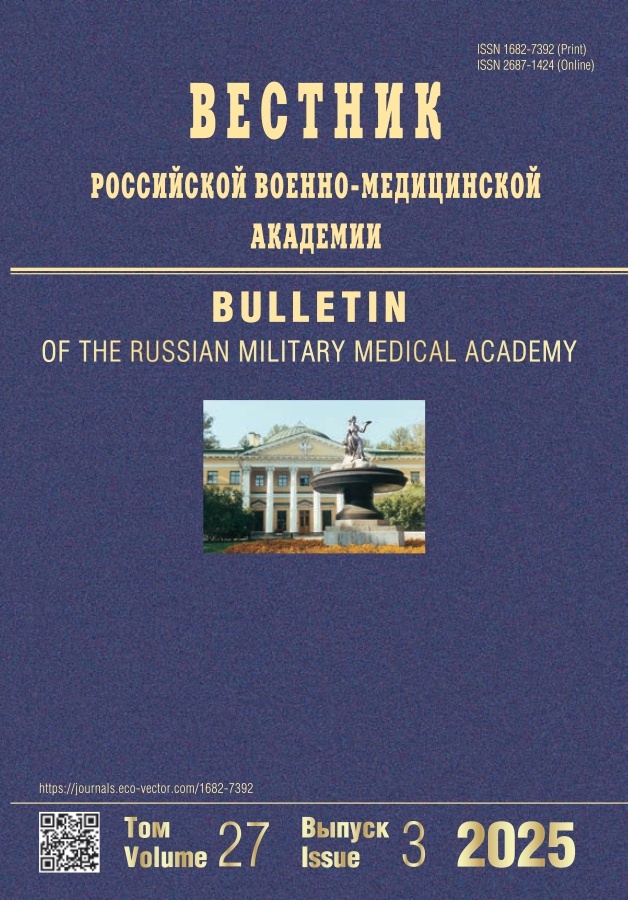Early diagnosis of violation of mineral metabolism, as a way of primary and secondary prevention of fractures Arctic army groupings
- Authors: Tyrenko VV1, Aganov DS1, Toporkov MM1, Tsygan EN1, Bologov SG1
-
Affiliations:
- Военно-медицинская академия им. С.М. Кирова
- Issue: Vol 20, No 4 (2018)
- Pages: 45-51
- Section: Articles
- URL: https://journals.rcsi.science/1682-7392/article/view/12257
- DOI: https://doi.org/10.17816/brmma12257
- ID: 12257
Cite item
Full Text
Abstract
Full Text
##article.viewOnOriginalSite##About the authors
V V Tyrenko
Военно-медицинская академия им. С.М. Кирова
Email: vmeda-nio@mil.ru
Санкт-Петербург
D S Aganov
Военно-медицинская академия им. С.М. Кирова
Email: vmeda-nio@mil.ru
Санкт-Петербург
M M Toporkov
Военно-медицинская академия им. С.М. Кирова
Email: vmeda-nio@mil.ru
Санкт-Петербург
E N Tsygan
Военно-медицинская академия им. С.М. Кирова
Email: vmeda-nio@mil.ru
Санкт-Петербург
S G Bologov
Военно-медицинская академия им. С.М. Кирова
Email: vmeda-nio@mil.ru
Санкт-Петербург
References
- Авцын, А.П. Микроэлементозы человека: этиология, клас- сификация, органопатология / А.П. Авцын [и др.]. - М.: Медицина, 1991. - 496 с.
- Агаджанян, Н.А. Эколого-биогеохимические факторы и здоро- вье человека / Н.А. Агаджанян [и др.] // Экология человека. - 2000. - № 1. - С. 3-5.
- Арнольди, И.А. Акклиматизация человека на севере и юге / И.А. Арнольди. - М.: Медгиз, 1962. - 72 с.
- Бабенко, Г.А. Микроэлементозы человека: патогенез, профи- лактика, лечение / Г.А. Бабенко. - М.: Медицина, 2001. - 316 с. 50 4 (64) - 2018 ВЕСТНИК РОССИЙСКОЙ ВОЕННО-МЕДИЦИНСКОЙ АКАДЕМИИ Клинические исследования
- Государственная программа «Социально-экономическое развитие Арктической зоны Российской Федерации на период до 2020 года». Постановление Правительства РФ от 21.04.2014 г. № 366. - Собрание законодательства РФ, 05.05.2014, № 18, ст. 2207. - М.: Изд-во Юрид. лит. - 2014. - С. 6573-6639.
- Деряпа, Н.Р. Адаптация человека в полярных районах Земли / Н.Р. Деряпа. - Л.: Медицина, 1977. - 160 с.
- Казначеев В. П. Биосистема и адаптация / B.П. Казначеев. - Новосибирск: Советская Сибирь, 1993. - 76 с.
- Казначеев, В.П. Проблемы «Сфинкса XXI века». Выживание населения России / В.П. Казначеев [и др.]. - Новосибирск: Наука, 2000. - 232 с.
- Основы государственной политики Российской Федерации в Арктике на период до 2020 года и на дальнейшую перспек- тиву: утв. Президентом РФ от 18 сентября 2008 г. // Росс. газета. - 27 марта 2009 г. - № 4877. - С. 32.
- Постановление Правительства РФ от 04.07.2013 г. № 565 (ред. от 19.07.2016) «Об утверждении Положения о военноврачебной экспертизе» -Собрание законодательства РФ, 15.07.2013, № 28, ст. 3831. - М.: Изд-во Юрид. лит. - 2013. - С. 7486-7596.
- Elffors, I. The variable incidence of hip fracture in southern Europe: the MEDOS Study // Osteoporosis int. - 1994. - Vol. 4, № 5. - P. 253-263.
- Lehtonen-Veromaa, M.K. Vitamin D and attainment of peak bone mass among peripubertal Finnish girls: A 3-y prospective study // Am. J. Clin. Nutr. - 2002. - Vol. 76. № 6. - P. 1446-1453.
- Meier, C. Supplementation with oral vitamin D3 and calcium during winter prevents seasonal bone loss: A randomized controlled open-label prospective trial / C. Meier, H.W. Woitge, K. Witte [et al.] // J. Bone Miner. Res. - 2004. - Vol. 19, № 8. - P. 1221-1230.
- Woitge, H.W. Circannual rhythms and interactions of vitamin D metabolites, parathyroid hormone, and biochemical markers of skeletal homeostasis: a prospective study / H.W. Woitge, A. Knothe, K. Witte [et al.] // J. Bone Miner. Res. - 2000. - Vol. 15, № 12. - P. 2443-2450.
Supplementary files







